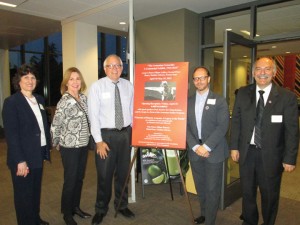Marine Vardanyan
Editor

Fresno State’s Leon S. Peters Ellipse Gallery, located on the second floor of the Madden Library, has been transformed into a glimpse into the world of the Armenian Genocide. “The Armenian Genocide: A Centennial Exhibit, 1915-2015” organized by the Armenian Studies Program opened on Friday, April 10, with a reception co-sponsored with the Friends of the Madden Library.
The Exhibit was made possible through a generous donation from the Thomas A. Kooyumjian Family Foundation and the Leon S. Peters Foundation.
Fresno State President Dr. Joseph I. Castro and Provost and Vice-President for Academic Affairs Dr. Lynette Zelezny attended the opening reception. “We are so deeply pleased to have the symbolic representation of the values that this community brings to us and the connection that the university has to the work that is happening,” said Zelezny.
The Exhibit presents students and community members with a narrative of the Armenian Genocide told through photos and artifacts relating to the Genocide from all over the world.
“In planning this exhibit, we kept in mind that the Armenian people have had a long and proud history,” said Professor Barlow Der Mugrdechian, Coordinator of the Armenian Studies Program. “We wanted people to begin their journey through the Exhibit by showing something of the place, Armenia, as well as highlighting the life of the people who once lived in Armenia.”
The Exhibit captures the story of the Armenian people, beginning with life before the Genocide. Displays of rare photographs, musical instruments, and videos of Armenians in their daily routines provide a way for guests to visualize Armenian life before the massacres began. The Exhibit guides visitors through the historic events, with disturbing images of cruelty including starving children, deportations, lifeless bodies, and proud faces of Ottoman perpetrators. Visual documentation was selected from a variety of collections, giving insight into the happenings of the Genocide through different perspectives and never before seen images.
 Many of the photos were from the newly released series “Iconic Images of the Armenian Genocide,” provided by the Armenian Assembly of America, the Armenian National Institute, and the Armenian Genocide Museum and Institute of Armenia.
Many of the photos were from the newly released series “Iconic Images of the Armenian Genocide,” provided by the Armenian Assembly of America, the Armenian National Institute, and the Armenian Genocide Museum and Institute of Armenia.
Visitors also got a close-up of the posters created by the United States in efforts to collect funds for the Armenians. The American Committee for Relief in the Near East, today known as the Near East Relief, mounted the largest humanitarian intervention program in American history.
Through such aid, a number of Armenians managed to escape the Genocide and arrive to the United States, with some settling in the San Joaquin Valley. The stories of Armenian migration to Fresno were placed in the final section of the Exhibit. Black and white photos of some of the first Armenians to settle in Fresno illustrated the triumph of the Armenian people despite all attempts to eliminate them. Armenian Genocide Centennial posters submitted by graphic design students for the Armenian Studies Program highlighted the last section of the Exhibit. Thus, the Armenian experience from 1915-2015 was presented through the Exhibit, producing feelings of sorrow, hope, and triumph.
“When we conceived of the idea of the layout, we conceived of it as a journey,” said Der Mugrdechian. Student Margaret Srmayan played a major role in helping to create that journey. Double-majoring in fine arts and theater arts design, Srmayan was thrilled to receive an invite to assist with the Exhibit.
“This project feels very personal to me. I am the great-granddaughter of Genocide survivors and now I am the only Armenian student in my department. I feel nothing but privileged and grateful to be part of this project.”
Malina La Porta prepared the cases for the Exhibit telling a variety of stories and Steve Ruppel provided invaluable assistance in the preparation of the Exhibit. Dr. Sergio La Porta assisted in the preparation of captions and historical background for the Exhibit.
Noah Files was instrumental in the construction of the walls for the Exhibit and a large crew of ASO members assisted in setting up the Exhibit.
The Leon S. Peters Ellipse Gallery was converted into a room with free-standing deep red walls that dominated the space and set an appropriate atmosphere for the somber occasion.
“The Armenian Genocide: A Centennial Exhibit 1915-2015” brings the story of the Armenian Genocide to a wider community.
The second part of the Exhibit, a fascinating collection of Armenian Church photographs by Richard and Anne Elbrecht, is located on the third floor of the Library, in the Pete P. Peters Ellipse Gallery.
The exhibits will remain open during regular hours of the Henry Madden Library through May 29. http://libguides.csufresno.edu/library_hours
 Hye Sharzhoom Armenian Action
Hye Sharzhoom Armenian Action